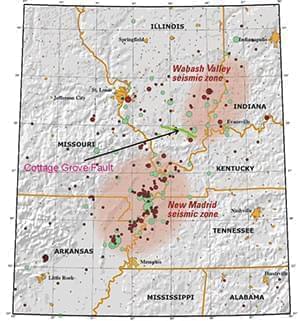How Common Are Earthquakes In Central Illinois?
Like the fault lines they stem from, earthquakes are often little thought of until they actually happen. But Tim Larson, a senior geophysicist at the Illinois State Geological Survey, is bringing them back to mind with his presentation - “Earthquakes: Fact and Fiction” at Parkland's Staerkel Planetarium on Friday.
Larson says that one of the biggest misconceptions around earthquakes here is that they don’t happen.

This map of the New Madrid and Wabash Valley seismic zones shows earthquakes as circles. Red circles indicate earthquakes that occurred from 1974 to 2002 with magnitudes larger than 2.5. Green circles denote earthquakes that occurred prior to 1974. Larger earthquakes are represented by larger circles. The Cottage Grove Fault is indicated by the green line.
But, earthquakes can, and do, happen here, generally coming from the Wabash Valley Seismic Zone or the New Madrid Seismic Zone.
While smaller earthquakes are more common (we’ll have one about every decade), a large earthquake is possible.
“We’ve had magnitude 5 earthquakes - could be up to magnitude 6,” said Larson, who said his talk was inspired by the facts, and the fiction, behind last summer's blockbuster hit San Andreas.
Exactly why they happen here is less certain – “the dynamics, the mechanics, are much more difficult to understand in the center of a plate – [there are] fewer earthquakes so there’s fewer data to go on,” said Larson.
Another big difference is that the energy from the earthquakes we have here travels farther. Larson says this is because the crust is older and stiffer.
As to how Hollywood deals with earthquakes? Larson says they tried to do a good job, but did get a few things wrong. He’ll go into more detail at his talk. That talk - “Earthquakes: Fact or Fiction” - is at 7 p.m. at Parkland's Staerkel Planetarium on Friday. Admission is free.

